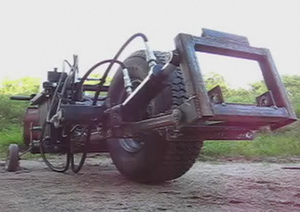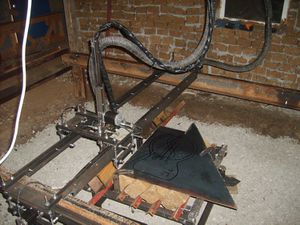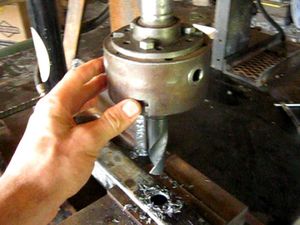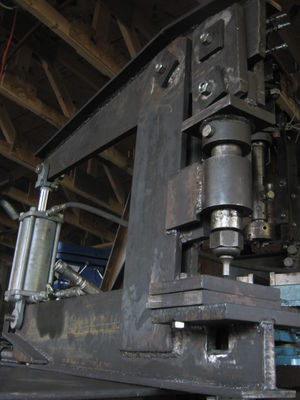Crash course on OSE/es
| Curso Acelerado Esto es un Curso Intensivo sobre Ecología de Código Abierto (OSE por sus siglas en inglés). En los próximos 15 minutos, te actualizarás sobre todo el trabajo de OSE desde 2007 aproximadamente. Escribe a crashcoursemoderator arroba gmail punto com para recibir ayuda. Ver también Resumen Técnico del GVCS. |
Resumen para la gente nueva
Para ver lo que hacemos, mira el vídeo GVCS en 2 Minutos. Ecología de Código Abierto la fundó en 2004 Marcin Jakubowski. Somos una red de agricultores, ingenieros, y quienes hemos apoyado en los dos últimos años la creación del Set de Construcción de la Aldea Global (GVCS, siglas en inglés), de código abierto, de bajo coste, una plataforma de alto rendimiento tecnológico que permite la fácil construcción, DIY (hágalo usted mismo) de las 50 diferentes Máquinas Industriales que se necesitan para construir una civilización sostenible con las comodidades modernas. El GVCS reduce las barreras a la entrada en la agricultura, la construcción y fabricación, y puede ser visto como un conjunto de herramientas modulares al estilo lego a tamaño real, que pueden desarrollar economías enteras, ya sea en la zona rural de Missouri, donde se fundó el proyecto, en el desarrollo urbano , o en el corazón de África.
Tenemos un ambicioso programa para lanzar los productos de las 49 tecnologías restantes dentro de 2 años y un presupuesto de 2.400.000 $ - que abreviamos como nuestro programa 50/2/2. El plazo pevisto es el 2011-2012.
Características Clave del GVCS
Éstas son las Características Clave del GVCS, y si queréis ver la lista de valores, id a Valores Centrales de la TCA.
Características Clave
|
Alcance del GVCS
Alcance
|
Estado Actual
last updated: 25. April 2011.
Los siguientes prototipos y productos desarrollados hasta ahora:
| LaPrensa LTC (Ladrillos de Tierra Compactada) permite construir a partir de la propia tierra del terreno de forma rápida (16 ladrillos por minuto), a bajo coste y con alta calidad. La Prensa LTC se usa para comprimir terreno arcilloso (20-30% de arcilla en volumen) de tierras locales, convirtiéndolo en bloques de construcción estructurales (700-1000 PSI). La estabilización con cemento se puede usar para hacerlos más resistentes a las condiciones climatológicas. LTC también se presta a la construcción de suelos, áreas pavimentadas, muros de contención, estructuras de almacenamiento o cualquier otra estructura donde se necesiten estos bloques.
Links: The Liberator, The CEB Story, initial field testing, pressing bricks, disassembly, crating (packaging), machine overview, the frame, the controller, CEB Machine Controller: Fabrication Recursion, Complete CEB Walkthrough. Documentación: Introduction, Build Instructions, CAD Files | |
| LifeTrac es un versátil tractor hidráulico a tamaño completo que gira mediante derrape y con cuatro ruedas. Tiene una potencia de 18-200 hp y las cadenas de oruga de acero son opcionales. El LifeTrac pretende ser minimalista pero de alto rendimiento, diseño de por vida y que permita ser desmontado y con capacidad de trabajo y potencia tales que permitan cualquier operación en el terreno. Destaca su versatilidad y alto nivel de servicio. Su naturaleza modular permite que se le añadan accesorios; los generadores de potencia (Power Cubes) se pueden intercambiar y acumular adaptando la potencia a las necesidades específicas; rápida conexión de todos los componentes hidráulicos mediante mangueras de enganche rápido; incluye motores hidráulicos fácilmente intercambiables para usarlos en otras aplicaciones.
Links: Stage I of Development, Prototype II Completed, moving. Documentación: Build (wiki page with videos), Blender Files; Quick Attach Plate and Tracks CAD | |
| MicroTrac is a scaled-down, walk-behind version of the the full-sized LifeTrac to address the need for a microtractor. Estamos usando la mayoría de componentes como LifeTrac, except we are shrinking the structural members – to retain part interchangeability between MicroTrac and LifeTrac.
Links: Prototype I completed blog post, prototype I completed video, zero turn, Microtrac Prototype II, Prototype II Challenge. Documentation: wiki documentation ; Prototype I Blender File | |
| The Soil Pulverizer can be attached to LifeTrac and pulverizes the soil to a fine consistency which can be used in preparation for pressing Compressed Earth Bricks (CEBs).
Links: blog, construction and test (short video), test (video). | |
| The Power Cube II is an universal, self-contained power unit that consists of an engine coupled to a hydraulic pump for providing power to different devices in the form of hydraulic fluid at high pressure. The Power Cube is a module that can be attached to the LifeTrac, Microtrac, Bulldozer, and Open Source Car (OSCar) platforms. It connects to other devices via quick couplers and quick-connect hydraulic hoses.
Links: short and long (50min) video. Documentation: Blender Files. | |
| CNC Torch Table is a cutting table. A computer can control the torch head making clean sharp cuts on XYZ axes. Prototype I has been built, but has not been operated successfully because the radiation emitted by the plasma cutter that was used with the table caused electronics failure. We will finish Prototype I by retrofitting it with open source stepper motor controllers.
Links: wiki page, Plasma cutter in action, Open Source Torch Table Part 4, Part 5, Part 6. Documentation: Build (wiki), Blender File; Prototype I First Fire | |
| The Drill Press is for drilling 1″ and larger holes directly in metal without pre-drilling. It contains a hydraulic motor for the drilling and a hydraulic cylinder for the down pressure – so this is a literal press, and it is not short on torque or power as the motor can sustain up to 20 hp. We are using our Universal Rotor for the motor.
Links: video Documentation: documentation | |
| The Ironworker Machine is a device that can instantly cut steel and punch holes in metal thicknesses of 1". Currently the 150 Ton Hole Puncher is prototyped.
Links: 150 Ton Hole Puncher's blog post Documentation: Hole Puncher's Wiki Docu, Wiki Category |
Currently we are prototyping:
CNC Torch Table I
Power Cube III
LifeTrac III
Soil Pulverizer III
Solar Concentrator I
Steam Engine I
Industrial Robot I
Research is going on:
Nickel-Iron Batteries
Ecología de Código Abierto ganó el MAKE Green Project Contest.
Nuestra página web: http://opensourceecology.org
En marzo de 2011, Marcin dió la siguiente micro-charla: TED Talk. Desde entonces, el proyecto llamó la atención y ganó popularidad.
Headline text
Future Plans
Proposal 2012 contains all the updated information about the vision of the GVCS. The goal is to gather $2.4M of support to complete the GVCS in 2 years (the end of 2012).
GVCS components expected in 2011 are:
- Power Cube III – 55 HP (Horse Power)
- CNC Torch Table I
- LifeTrac III
- Soil Pulverizer III
- Modern Steam Engine I – Our goal is on the order of $500 in materials cost for a 1 kW generator, with favorable cost scaling for higher power. Introduction and more videos are available here: 1 kW Steam Engine Electric Generator Prototype
- Ironworker machine II
- Aluminum extraction from clay
If funding and collaborators are found, other parallel developments are possible.
Actualmente tenemos 4 tractores, 4 prensas CEB, 8 Power Cubes y 2 Pulverizadores Soil to be built till the end of Mai. El CNC Torch Table está en proceso para ayudar con esto.
Construction business using the Tractor-Soil Pulverizer-Compressed Eearth Brick (CEB) Press package will start in Los Angeles by an early adopter, Joskua Designs. This will be the first field testing outside of Factor E Farm. The building project in California will have to deal with earthquake codes.
Buscamos active collaboration en todos nuestros proyectos.
Está planeado para julio completar el modular CEB workshop.
We will also do prototype CEB/straw housing units with the assistance from our new Polish friends to build out as needed to accommodate other developers at Factor e Farm.
We'll be holding our first major Factor e Farm Convergence (Kansas City Area) on September 1-30 at Factor e Farm, to make major strides on the ground with respect to the Global Vilage Construction Set (GVCS) development.
Distributed power generation is a clear goal – the next major field of endeavor for Factor e Farm, which would allow us to fuel our operation for free – from agriculture, off-grid fabrication workshop, to living and transportation.
After the GVCS completion the first OSE Community will be built and Education and Training in 2-year immersion program are planned.
Adam Shilling, a True Fan, is planning a multiplayer online game based on the GVCS as the inspiration for its connection to the real world. Adam is going to South America to meet real people – to assess the needs of real communities. The project will link gaming to the real world – where money exchanged ends up purchasing things like tractors or renewable energy equipment for villages in South America.
A Documentary Film about Factory E Farm may come in the future.
Support OSE and collaborate with us to help us make this happen.
Our current needs are listed in the Project needs.
Getting Involved
| Get yourself involved! If you liked what you've seen, please check the Get involved page to see the various ways you can contribute your time and skills to our project |
If you want to join quickly some of the project, then check the Guide to OSE Projects.
Media and Interviews
For Interviews, please check our Press Procedure. Here you can find High Resolution GVCS Media.
Palabras Clave
Lectura requerida para desarrolladores
- OSE Specifications
- Proposal 2012
- GVCS Development Template
- Product Template
- Development Team
- Wiki Policy
- Forum Policy
Otros
- Conferences
- Media Development
FAQs
Trabajos pendientes
Conoce GVCS Tasks y Project needs.







